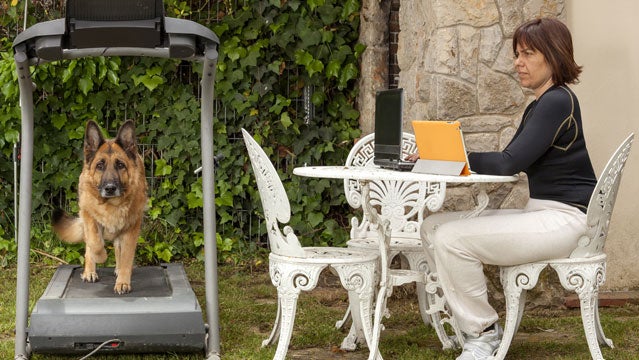It may not be the only reason you took in a four legged friend, but many active folk get a dog with the hope they are also getting a loyal training buddy and adventure partner. And, true enough, dogs can enjoy trail runs and mountain-bike rides as much as you.
But also like you, dogs are at risk if they just jump off the couch and bust out a 10K.
“You can’t have your dog be a weekend warrior,” says Vail, Colorado, , who has worked with active dogs for 25 years. “You can’t have them sit on the couch all week, and then go do this big thing all weekend.”
Your dog won’t tell you if she’s tired or hurting, so it’s up to you to manage proper exercise and to help keep them injury-free.
Conditioning Your Canine
“A dog will run with you until he dies, but you really need to build up exercise over six to eight months, until they can do what a mature (human) endurance athlete can do,” says .
Start out with shorter workouts. Begin with distances of one to three miles, incorporating a good warm-up, then build from there.
That progression goes for new activities, too. If your dog doesn’t usually walk off road, start with some shorter trail hikes to get their paws up to the task. Scrambling over boulders on a 14er, for example, is difficult for dogs, but they can be trained for the ascent by tackling smaller climbs for a few weeks prior. Want them to join you for mountain-biking? Start them on shorter rides, on easier trails.
“Before you take your dog on an experience like that, you need to know what the situation is going to be and train them for it,” says Ruark. “They can get used to anything, but you need to ease them into it.”
Veterinarians also caution against starting dogs on endurance activities too young, since excessive exercise can damage developing joints and bones. Ask your vet about your dog, but in general, small breeds are fully developed by 9 months, and medium and large breeds from 12 to 18 months.
Watch carefully after workouts to know your dog’s limits. You may think you’re giving your dog a challenge, but too much exercise can cause permanent damage to hips and elbows down the road.
“If they’re tired its one thing. If they’re limping or sore, back off,” says Sheldon.
Take the type of dog into consideration, too—”smashed faced” breeds such as pugs and Boston terriers may have trouble breathing.
Come, Sit, Hike
Everyone wants their dog running free on the trails, but in reality, you need a well-trained, well-socialized dog that can accompany you in your athletic endeavors.
Ruark says the most important commands a sporting dog can know are, “come,” “leave it,” “back,” “up,” “in,” and “away.”
The last four help you control your dog when he’s on heel, and keep him a safe distance from boots, bikes, skis, snowshoes, and the like.
“Whatever commands you choose, the important thing is to have control,” says Ruark, who has taught clients and their dogs how to ski together. “Have a speed-up and slow-down command. They need to learn to stay with you and stay focused on you.”
Check up on leash laws, too, to avoid getting slapped with some hefty fines.
Kibble Them Fit
Countless books and magazines that help humans eat right to maximize athletic performance. But what about dogs? The rules are similar.
Highly active dogs need diets higher in protein (about 30 percent) and fat (15 to 25 percent), and only about 10 to 15 percent from carbohydrates. Average dog foods contain only about 20 to 22 percent protein, and more carbs than needed. Check the kibble nutrition label, or supplement your dog’s diet with plain-cooked turkey, chicken, or eggs. Sheldon often recommends puppy chow for his clients—the kibble has higher fat and protein content, as well as those beneficial nutrients that can help puppies grow and keep active adult dogs healthy.
Two other supplements that will help the active dog are omega-3 fatty acids, which keep inflammation down, and glucosamine (1,000-1,500 milligrams a day), to keep hips and joints moving smoothly.
“One University of Florida study showed that dogs who have glucosamine at an early age have less problems later down the line,” says Sheldon. “It comes in treat form, or you can give the human kind. At the least, it’s harmless, cheap, and well-tolerated.”


